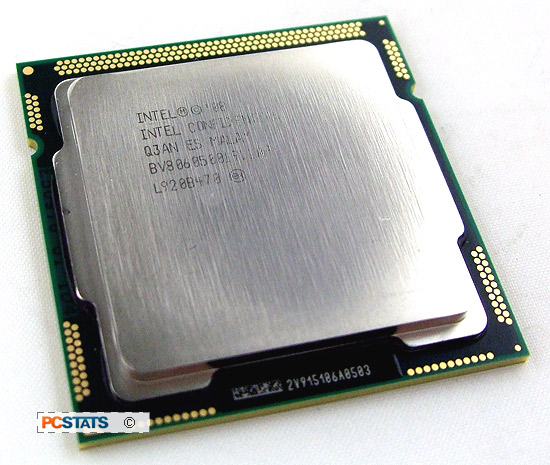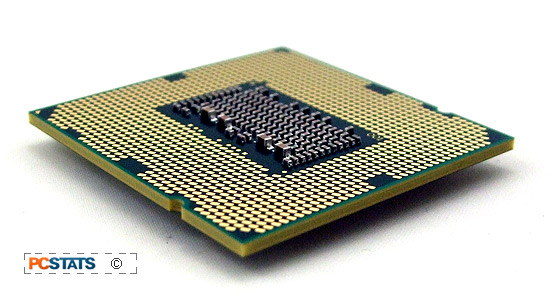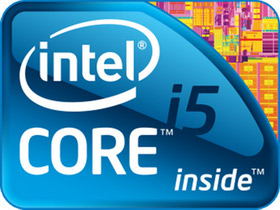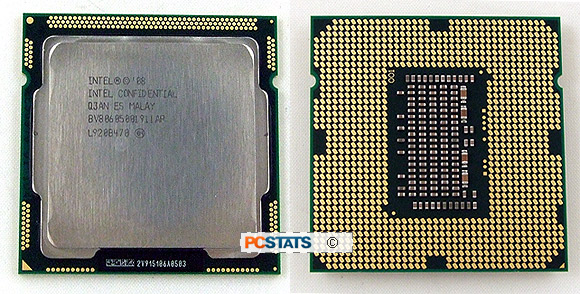The Intel Core i5 750 processor is a mainstream quad-core CPU that promises
enthusiast-level performance for the masses. The Core i5 750
is part of Intel's most recent generation of socket 1156 processors which include not
only the Intel Core i5 700-series but also several Intel Core i7 800-series chips, code named
"Lynnfield". These processors are the affordable, mainstream variant
on Intel's "Nehalem" microarchitecture, a codename that should be
familiar to PC enthusiasts by now: it's the same highly parallel, low-latency architecture that powers Intel's Core i7 920, 950,
and 975 Extreme Edition processors.
Intel's Core i5 750 processor is actually one of three
processors initially launched by Intel. It's joined by the Core i7 860 and Core
i7 870 processors. These are the first three processors for Intel's socket 1156,
and consequently the first processors that can use Intel's P55 Express chipset.
There is a flurry of motherboards using this new chipset, and PCSTATS has done a
few reviews of motherboards based on the Intel P55 Express
chipset, which are recommended reading if you want the big picture on
"Lynnfield".
Although it's the entry model for this new socket format,
the Core i5 750 still packs quite a punch. It's a quad-core (4 core / 4 thread)
processor that runs at a native 2.66GHz with 256KB of L2 cache per core and a
large 8MB shared cache. Unlike its Intel Core i7 brothers, the Core i5 750
doesn't have HyperThreading, a multi-threading technique that allows each core
to execute two threads at once. This will hold it back in certain massively
parallel benchmarks and applications, like Cinebench.
To compensate for the lack of Hyperthreading, the Core
i5 750 features something called Turbo Boost, an
automatic overclocking mode that can turn up the frequency of the Core i5 750's
individual cores, based on current CPU load, heat and power levels. If only one
or two cores are under load, Turbo Boost may ramp the speed of the Core i5 750
all the way up to 3.2GHz if needed. PCSTATS will be taking a closer look at
Turbo Boost and manual overclocking for the Intel Core i5 750 later on in this
processor review.
 |
|
|
Intel Core i5
750 processor |
|
|
 |
| Tech
Specs |
|
Core i5
750
Clock: 2.66 GHz
Codename: Lynnfield Cores: 4 (physical) 4
(logical)
L1: 2 x 64K
L2: 256KB per core
L3: 8MB shared
Multiplier:
20x
Package: LGA1156
Socket: 1156
organic mPGA
Core: 45nm
Transistor: 774M
Power: 95W Watts
Vcore: 0.850-1.3625V
Cost: $250 CDN

|
| |
Like the socket 1366 Core i7 900-series of processors,
Intel's socket 1156 Core i7 800-series and Core i5 700-series processors have an
on-die memory controller. While the socket 1366 processors use triple-channel
DDR3 memory, the socket 1156 processors use dual-channel DDR3 memory kits, which
are widely available and roughly the same price as DDR2 memory. Memory speeds up
to DDR3-1333MHz are supported.
 In addition to the integrated memory
controller, the die of the Core i5 750 also contains a PCI Express 2.0
controller with 16 lanes of bandwidth. Having integrated PCI Express
connectivity directly on the processor reduces latency, as well as eliminating
the need for a traditional Northbridge controller on the Intel P55 Express
chipset.
In addition to the integrated memory
controller, the die of the Core i5 750 also contains a PCI Express 2.0
controller with 16 lanes of bandwidth. Having integrated PCI Express
connectivity directly on the processor reduces latency, as well as eliminating
the need for a traditional Northbridge controller on the Intel P55 Express
chipset.
In fact, Intel P55 Express-based motherboards will not
only combine the northbridge and southbridge controller into a single controller
now called the Platform Controller Hub, they'll also remove the Front Side Bus
altogether. This should remove a lot of bandwidth bottlenecks and improve
overall processor-to-system connectivity.
Several motherboards based on the Intel P55 Express chipset are already hitting
retail shelves to coincide with the launch of the Core i5 700-series and Core i7
800-series of processors. However there's also a second-generation of Intel P55
Express motherboards that will include SATA 6 Gb/s connections waiting in the
wings.
 Since the Core i5 700-series and Core i7
800-series of processors uses an 1156-pad socket with different sizings than
Intel's existing socket 1366 or socket 775 processors, an entirely new heatsink
and fan will be required for cooling. As always, Intel ships these processors
with an appropriate stock cooler that should allow them to run at their default
speeds without any issues.
Since the Core i5 700-series and Core i7
800-series of processors uses an 1156-pad socket with different sizings than
Intel's existing socket 1366 or socket 775 processors, an entirely new heatsink
and fan will be required for cooling. As always, Intel ships these processors
with an appropriate stock cooler that should allow them to run at their default
speeds without any issues.
The Thermal Design Power (TDP) of the Core i5
700-series and Core i7 800-series of processors is a surprisingly low 95 Watts.
This is in part due to the 45 nanometre manufacturing process that Intel uses,
but is also part of an integrated power management controller that can disable
the Core i5 750's individual cores under light CPU loads.
Like the rest of the Core i5 700-series and
Core i7 800-series, the Core i5 750 processor has 774 million transistors on a
296mm2 die, which is a higher transistor count and larger die than Intel's Core
i7 900-series processors, thanks to the additional integrated PCI Express
controller.

Retailing for around $220 CDN ($200 USD, 125 £GBP), the Intel Core i5 750
processor costs about the same price as Intel's current mainstream Core 2 Duo E8500 processor, and significantly less
expensive than high-end quad core parts, like AMD's Phenom II X4 965 Black edition and Intel's Core i7 920
processors.
Will this new mainstream processor be able to hold its
own against some of PCSTATS' most highly-rated processors? PCSTATS has the
answers next....but first, what it takes to build an Intel Core i5 computer
system.

